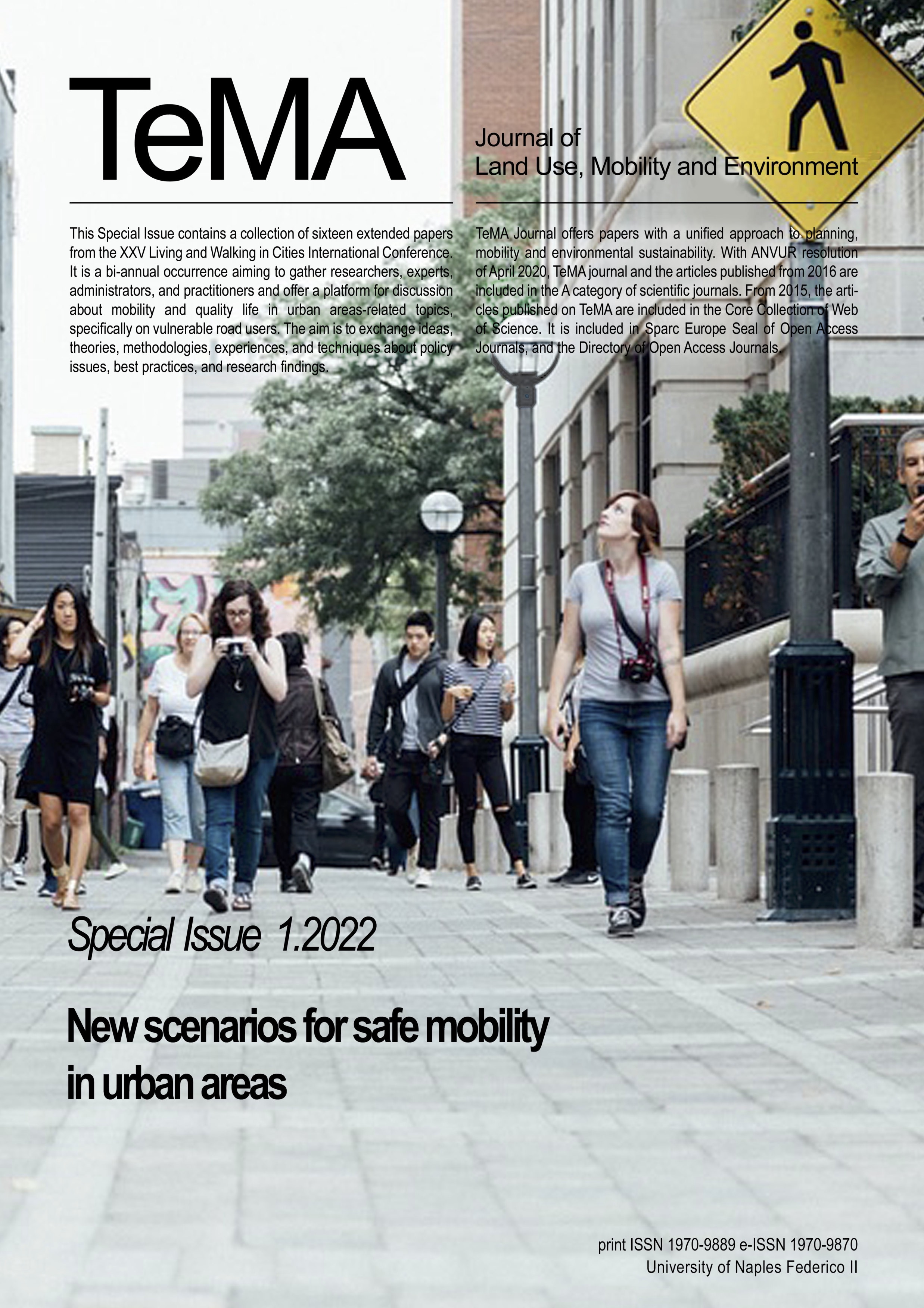New scenarios for safe mobility in urban areas: emerging topics from an international debate
Abstract
The paper presents the emerging topics of the international debate for safe mobility in urban areas with an innovative interpretation. This is the bibliometric mapping of the most recurrent concepts (keywords) of almost 80 scientific publications. The paper framework moves from the issue of the “sustainability” of cities to the “safe” and “innovative” city through a mobility lens. In Europe by 2030 cities have to become climate-neutral and some main urban strategy to achieve this result is focused on transport and mobility sectors. The interpretation of the bibliometric mapping results leads to highlighting the shortcomings of some topics within the scientific debate. The Qualiquantitaive Data Analysis was applied to set the interdependency among research fields and better understand the interrelation among the different topics. The key concepts of ‘time’ and ‘innovation’ don’t emerge clearly as an object of research and they will be included in future reflections about the transformative capacity of the city through sustainability and in the development of city strategies.
Downloads
References
Castán Broto, V., Trencher, G., Iwaszuk, E., & Westman, L. (2019). Transformative capacity and local action for urban sustainability. Ambio, 48(5), 449-462. https://doi.org/10.1007/s13280-018-1086-z
European Commission. (2018). EUROPE ON THE MOVE. Sustainable Mobility for Europe: safe, connected and clean. Strategic Action Plan on Road Safety. (COM(2018) 293 final - Annex 1). Brussels: EC Retrieved from https://eur-lex.europa.eu/resource.html?uri=cellar%3A0e8b694e-59b5-11e8-ab41-01aa75ed71a1.0003.02/DOC_2&format=PDF
European Commission. (2019a). EU Road Safety Policy Framework 2021-2030 - Next steps towards "Vision Zero". (SWD(2019) 283 final). Brussels: EC Retrieved from https://ec.europa.eu/transport/road_safety/sites/default/files/move-2019-01178-01-00-en-tra-00_3.pdf
European Commission. (2019b). Road safety 2018 – How is your country doing? M. a. T. D. EC. https://ec.europa.eu/transport/road_safety/sites/default/files/pdf/scoreboard_2018_en.pdf
European Commission. (2020). Sustainable and Smart Mobility Strategy – putting European transport on track for the future. (COM(2020) 789 final). Brussels: EC Retrieved from https://eur-lex.europa.eu/resource.html?uri=cellar:5e601657-3b06-11eb-b27b-01aa75ed71a1.0001.02/DOC_1&format=PDF
Hofmann, T. (2001). Unsupervised Learning by Probabilistic Latent Semantic Analysis. Machine Learning, 42(1), 177-196. https://doi.org/10.1023/A:1007617005950
Litman, T. (2021). Not So Fast. Better Speed Valuation for Transportation Planning. Victoria Transport Policy Institute, 27.
Popescu, A. I. (2020). Long-Term City Innovation Trajectories and Quality of Urban Life. Sustainability, 12(24). https://doi.org/10.3390/su122410587
Sim, D. (2019). Soft City: Building Density for Everyday Life. Island Press.
UN-Habitat. (2020). World Cities Report 2020. The Value of Sustainable Urbanization. UN. https://unhabitat.org/sites/default/files/2020/10/wcr_2020_report.pdf
van Eck, N. J., & Waltman, L. (2010). Software survey: VOSviewer, a computer program for bibliometric mapping. Scientometrics, 84(2), 523-538. https://doi.org/10.1007/s11192-009-0146-3
van Eck, N. J., Waltman, L., Noyons, E. C. M., & Buter, R. K. (2010). Automatic term identification for bibliometric mapping. Scientometrics, 82(3), 581-596. https://doi.org/10.1007/s11192-010-0173-0
World Resources Institute, & Global Road Safety Facility. (2018). SUSTAINABLE & SAFE. A Vision and Guidance for Zero Road Deaths. EMBARQ. https://thedocs.worldbank.org/en/doc/912871516999678053-0190022018/original/ReportSafeSystemsfinal.pdf
Copyright (c) 2022 TeMA - Journal of Land Use, Mobility and Environment

This work is licensed under a Creative Commons Attribution 4.0 International License.
Authors who publish in this journal agree to the following:
1. Authors retain the rights to their work and give in to the journal the right of first publication of the work simultaneously licensed under a Creative Commons License - Attribution that allows others to share the work indicating the authorship and the initial publication in this journal.
2. Authors can adhere to other agreements of non-exclusive license for the distribution of the published version of the work (ex. To deposit it in an institutional repository or to publish it in a monography), provided to indicate that the document was first published in this journal.
3. Authors can distribute their work online (ex. In institutional repositories or in their website) prior to and during the submission process, as it can lead to productive exchanges and it can increase the quotations of the published work (See The Effect of Open Access)

